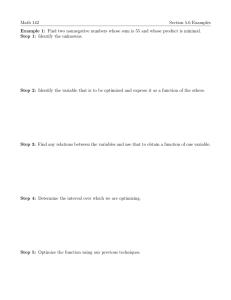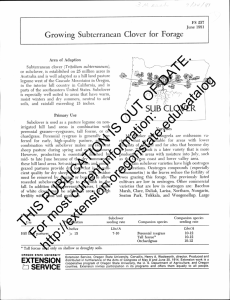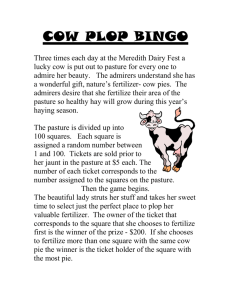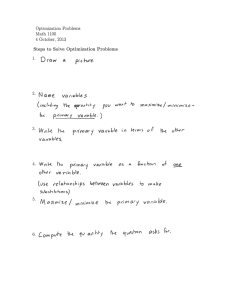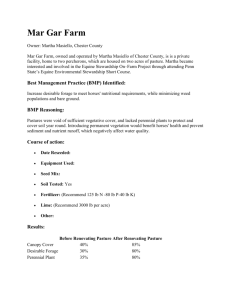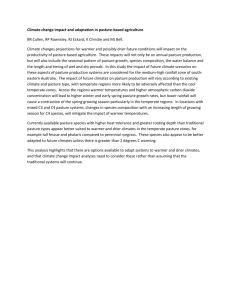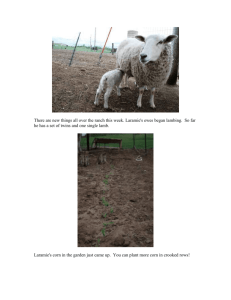Pasture response to fertiliser inputs under dairy grazing
advertisement
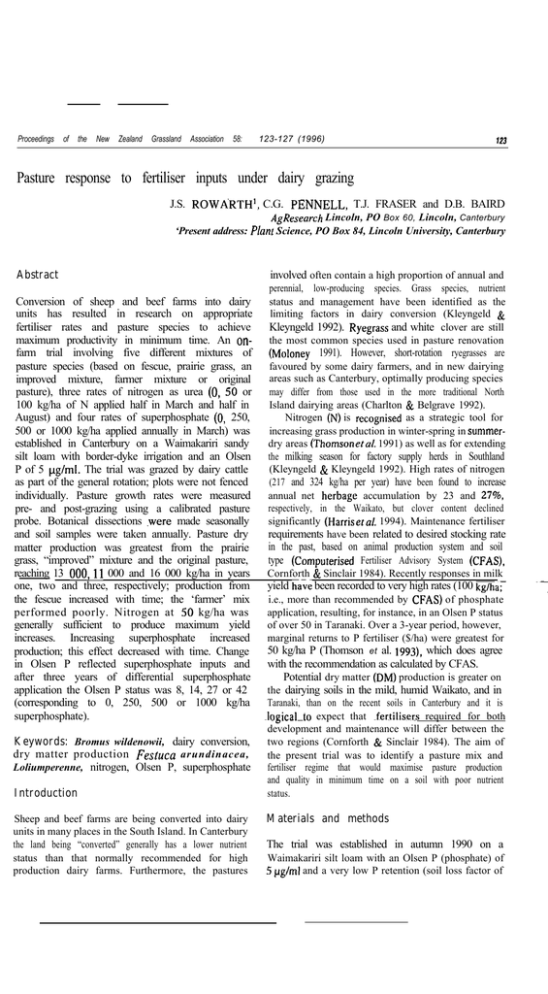
Proceedings of the New Zealand Grassland Association 58: 123-127 (1996) 123 Pasture response to fertiliser inputs under dairy grazing J.S. ROWARTH’, C.G. PENNELL, T.J. FRASER and D.B. BAIRD AgResearch Lincoln, PO Box 60, Lincoln, Canterbury ‘Present address: PIant Science, PO Box 84, Lincoln University, Canterbury Abstract Conversion of sheep and beef farms into dairy units has resulted in research on appropriate fertiliser rates and pasture species to achieve maximum productivity in minimum time. An onfarm trial involving five different mixtures of pasture species (based on fescue, prairie grass, an improved mixture, farmer mixture or original pasture), three rates of nitrogen as urea (0, 50 or 100 kg/ha of N applied half in March and half in August) and four rates of superphosphate (0, 250, 500 or 1000 kg/ha applied annually in March) was established in Canterbury on a Waimakariri sandy silt loam with border-dyke irrigation and an Olsen P of 5 pg/ml. The trial was grazed by dairy cattle as part of the general rotation; plots were not fenced individually. Pasture growth rates were measured pre- and post-grazing using a calibrated pasture probe. Botanical dissections ,were made seasonally and soil samples were taken annually. Pasture dry matter production was greatest from the prairie grass, “improved” mixture and the original pasture, reaching 13 000,ll 000 and 16 000 kg/ha in years one, two and three, respectively; production from the fescue increased with time; the ‘farmer’ mix performed poorly. Nitrogen at 50 kg/ha was generally sufficient to produce maximum yield increases. Increasing superphosphate increased production; this effect decreased with time. Change in Olsen P reflected superphosphate inputs and after three years of differential superphosphate application the Olsen P status was 8, 14, 27 or 42 (corresponding to 0, 250, 500 or 1000 kg/ha superphosphate). Keywords: Bromus wildenowii, dairy conversion, dry matter production Festuca arundinacea, Loliumperenne, nitrogen, Olsen P, superphosphate Introduction Sheep and beef farms are being converted into dairy units in many places in the South Island. In Canterbury the land being “converted” generally has a lower nutrient status than that normally recommended for high production dairy farms. Furthermore, the pastures involved often contain a high proportion of annual and perennial, low-producing species. Grass species, nutrient status and management have been identified as the limiting factors in dairy conversion (Kleyngeld & Kleyngeld 1992). Ryegrass and white clover are still the most common species used in pasture renovation (Maloney 1991). However, short-rotation ryegrasses are favoured by some dairy farmers, and in new dairying areas such as Canterbury, optimally producing species may differ from those used in the more traditional North Island dairying areas (Charlton & Belgrave 1992). Nitrogen (N) is recognised as a strategic tool for increasing grass production in winter-spring in summerdry areas (Thomsoneta/. 1991) as well as for extending the milking season for factory supply herds in Southland (Kleyngeld & Kleyngeld 1992). High rates of nitrogen (217 and 324 kg/ha per year) have been found to increase annual net herbage accumulation by 23 and 27%, respectively, in the Waikato, but clover content declined significantly (Harrisetaf. 1994). Maintenance fertiliser requirements have been related to desired stocking rate in the past, based on animal production system and soil type (Computerised Fertiliser Advisory System (CFAS), Cornforth & Sinclair 1984). Recently responses in milk yield have been recorded to very high rates (100 kg/hai.e., more than recommended by CFAS) of phosphate application, resulting, for instance, in an Olsen P status of over 50 in Taranaki. Over a 3-year period, however, marginal returns to P fertiliser ($/ha) were greatest for 50 kg/ha P (Thomson et al. 1993), which does agree with the recommendation as calculated by CFAS. Potential dry matter (DM) production is greater on the dairying soils in the mild, humid Waikato, and in Taranaki, than on the recent soils in Canterbury and it is logicallto expect that -fertilisers required for both development and maintenance will differ between the two regions (Cornforth & Sinclair 1984). The aim of the present trial was to identify a pasture mix and fertiliser regime that would maximise pasture production and quality in minimum time on a soil with poor nutrient status. Materials and methods The trial was established in autumn 1990 on a Waimakariri silt loam with an Olsen P (phosphate) of 5 pg/ml and a very low P retention (soil loss factor of IT 1.24 0.1). Sulphur in hcrbage in November was 0.38% Table I Sowing rates (kg/ha) for pasture mixes. indicating no deficiency (Cornforth and Sinclair, 1984). Pasture mixture The trial paddock was part of a normal dairy rotation Species Fescue Prairie grass Improved mix Farmer mix9 and was grazed in blocks. Individual plots were not Ryegrass’ 10 fenced separately. Existing pasture was pegged to give Fescue 2 20 15 main plots (0.2 ha) in 3 blocks. Within each of the Prairie3 30 15 Cocksfoot 3 blocks, 4 plots were sprayed twice with Roundup and Timothy5 2 then direct-drilled with one of 4 pasture mixes (Table W h i t e clover6 3 3 Red clover’ 3 3 1). Thus each block contained a plot of existing pasture. i Chicory8 1 Each of the pasture mixture plots comprised 3 border Total 26 36 37 27 irrigation strips which were were used as sub-plots for nitrogen application (0, 50 or 100 kg/ha of N as urea) For the fescue, prairie and improved mixes, cultivars used were ‘perennial ryegrass (Lolium perenne L.) cv. Grasslands Nui, 2tall half in March and half in August each year. Each of the fescue (Fesfuca arundinacea) cv. Grasslands Roa, 3prairie grass main plots was divided into 4 across the border strips (Bromus wildenowi0 cv. Grasslands Matua, Vocksfoot (Dacty/is glomerata) cv. Grasslands Kara, STimothy (Phleum prafense) cv. and superphosphate (0,250,500 or 1000 kglhalyr) was Grasslands Kahu, ‘white clover (Trifofium repens) cv. Grasslands applied in March. The trial design was a randomised Kopu, ‘red clover (Trifoliumpratense) cv. Grasslands Pawera, schicory complete block with N as split-plots. (Cichorium infybus) cv. Grasslands Puna. 9 This mix was based on short rotation ryegrass. perennial ryegrass In the analyses of variance for yield, the main plot and uncertified white clover. residual variance was approximately the same as the sub-plot residual variance leading to a single Table 2 Botanical composition in (a) spring 1990 and (b) autumn 1992. LSD rather than the usual range of LSDs normally associated with a split plot design. (a) Irrigation was applied at approximately 3Species Fescue Prairie grass Improved mix Farmer mix Orioinal weekly intervals during the summer. Monitoring Ryegrass 30 79’ 75 pasture growth began in spring 1990. A pasture Fescue 56 8 3 3 5 probe (Design Electronics), calibrated seasonally Prairie Cocksfoot to cut quadrats for each species, was used pre Timothy and post-grazing to assess dry matter yield. White clover 4 2 3 1 17 Red clover 5 Pasture growth rates (kg/ha/day) wcrc calculated 8 Chicory as the difference between post- and pre-grazing Other 41 15 20 20 8 Dead yields divided by the appropriate number of days. Seasonal dry matter yields were calculated * 23% perennial and 56% Moata from net accumulation rates extrapolated to tb) include grazing days as well as growing days. Fescue Prairie grass Improved mix Farmer mix Original Species Year three data comprised 9 months only, as Ryegrass 13 30* 50 measurements terminated when the cows were Fescue 37 dried off in autumn. Pasture species components Prairie 35 26 11 32 were assessed seasonally by botanical dissection. Cocksfoot 1 Timothy Soil was sampled in years 0, 1 and 3; samples White clover 25 24 23 16 18 were taken to 75 mm in February, before fertiliser Red clover 5 8 10 3 Chicory 4 application. “MAF Quick test” analyses Other 17 16.5 1 4 (Cornforth & Sinclair 1984) were done by Dead 16 16 11 18 29 AgResearch Invermay. all perennial l Results and discussion Pasture (DM) production DM production during the three years of the trial was affected by season; production was limited in winter by low soil temperatures and in mid summer by lack of peaked at only 80 kg/ha/day (cf. 120 kg/ha/day in years consequent low soil temperatures (3°C lower than normal during spring). In the first year the fescue and farmer mix produced significantly less (PcO.05) than the prairie grass, improved mix and original pasture (Figure 1). In year two only the farmer mix grew significantly less (P<O.O5) one and three), reflecting decreased radiation owing to than the other species. By year three there were no ash significant differences between species growth rates. soil moisture. In the second year pasture growth rates from the eruption of Mount Pinatubo and - - Figure I Main effect of species on annual DM production (kg/ ha). Bars are least significant differences (P<O.O5). did not survive. This was replaced by unsown cocksfoot and annual species such as goose grass (Bromus mollis). Nitrogen At all rates of superphosphate the treatments receiving 50 kg/ha N generally produced more dry matter than those receiving no N. Fifty kg/ha N gave an increase of 1500 kg/ha DM in year one and 800 in year two. There was little response to an additional 50 kg/ha N (Figure 2) except in the first spring when the clover component was low (Table 2a). Furthermore, addition of high rates of N tended to decrease clover content (5% cf. 25% in autumn; data not presented). The 100 kg/ha N treatment in year three gave only 500 kg/ha more DM than 0 kg/ha N. Figure 2 Main effect of nitrogen on annual DM production (kg/ ha). 16000 Thus the prairie grass and improved mix performed as well as the original from the beginning, and the performance of the fescue and farmer mix improved with time (Figure 1). As other field experiments have shown that the quality of prairie grass is inadequate for high animal performance, despite its DM production (Stevens et al. 1992), prairie grass is not recommended. Furthermore, white clover and timothy, which were constituents of the improved mix, have been shown to have a positive effect on milk solids (Johnson & Thomson 1996). as well as condition score (though the effect fis not significant) of dairy cows, which supports the use of the improved mix in dairy conversion. The farmer mix was uncertified seed and excavations in the first year showed that the clover was poorly nodulated. Improvement over time is believed to be because of germination of buried seed and ingress of clovers and cocksfoot. High DM residuals (800-1000 kg/ha cf. 500-800 on newly sown plots: data not presented) on the original pasture plots indicated that the cows preferred grazing - the newly s-own plols._Fu&erm.ore,~managementsfthe trial favoured the original pasture plots (rapid rotation, e.g., 7 days in spring, and high residuals leading to rapid regrowth because of leaf area remaining; Lemaire & Chapman 1996). Botanical composition Clover increased in the new pastures from about 3% in the first spring (Table 2a) to 10% in winter (data not presented) and 20% in autumn (Table 2b). The poor productivity of the farmer mix reflects the large component of Moata (identified at dissection) which 15000 f 14000 2 9 13000 .g g 12000 2 6 11000 10000 9000 --- ---o50 100 Rate of nitrogen (kg/ha N) Superphosphate There was a positive, significant and linear (PcO.01) response in DM to increasing rates of superphosphate application in years one and two of the trial (Figure 3). Increases achieved were small - 1000 kg/ha superphosphate produced only 1650 and 1960 kg/ha DM moreethan_theecontroILtreatments, -indicatinggthattP concentration was not the main limiting factor in production. In contrast, in year three the response was curvi-linear; applying 250 kg/ha superphosphate produced an extra 2500 kg/ha DM, whereas applying 1000 kg/ha superhosphate produced only another 1000 kg/ha DM. Soil P There was a positive, significant (PcO.05) response in Olsen P to increasing rate of superphosphate addition from year one of the trial (Table 3). Over the three years 128 of the trial there was a small increase (3 pg/ml) in Olsen P at 0 kg/ha superphosphate which reflected the cafeteria grazing inherent in the trial design, and consequent redistribution of P in faeces. This increase was smaller than might have been expected given the range of P treatments (O-1000 kg/ha superphosphate) but must be remembered when interpreting the yield response data. An increase of 3 pglml approximates to 33 kg/ha superphosphate (Metherell et al. 1995). Allowing for a 20% error in Olsen (Friesen & Blair 1984) this suggests that the amount of P transferred to the control plots was 26-43 kg/ha. (Roberts et al. 1994) stated that the biological optimum (arbitrarily defined as 97% maximum production) Olsen P test for sedimentary soils is 20, and the target range for Olsen P which will sustain maximum pasture production is 20-25. However, using their model, an Olsen P of 15, as achieved in the current experiment with an input of 250 kg/ha superphosphate, will give 95% maximum production. Figure 3 Main effect of superphosphate on annual DM production (kg/ha). 250 kg/ha of superphosphate (Table 4). This combination also produced optimally in year one (data not presented). In contrast, although the fescue plots gave maximum production from the highest rates of nitrogen and superphosphate (Table 5), it was not significantly different from that production achieved from 50 kg/ha N and 500 kg/ha superphosphate. The response in the prairie plots was similar to that of the fescue and the original plots responded to high superphosphate with zero N (data not presented). There were no significant interactions between N and superphosphate or superphosphate and species. There was a significant (PcO.01) interaction between species and N in each year of the trial; the farmer mix did not respond to N whereas all other species did. Table 4 Effect of fertiliser addition on DM yield (kg/ha) of the improved mixture in the third year of the trial. Superphosphate (kg/ha) ________________ Nitrogen 0 50 0 250 500 1000 Isd 5% 12220 16010 16190 16750 3420 Table 5 (kg/ha) 14465 14970 15530 16210 3420 _________________ 100 15180 17620 17750 17390 3420 Effect of fertiliser addition on DM yield (kg/ha) of fescue in the third year of the trial. Superphosphate ___.______------ Nitrogen (kg/ha) _________ ______. (kg/ha) 0 50 100 0 250 500 1000 Isd 5% 12205 14110 14920 14975 3420 15250 13865 17370 18380 3420 14213 15430 17110 18650 3420 Conclusions 0 I 0 I 250 I 500 ! 750 Rateof superphosphate(kgha) Table 3 Effect of superphosphafe on soil Olsen P (&/ml). Superphosphate (kg/ha) 0 250 500 1000 Isd5% 1991 5 16 14 20 8 1993 8 14 27 42 5 Interactions In the third year of the trial maximum production was achieved in the improved mixture with 100 kg/ha N and In this trial resowing did not increase DM production compared with the existing pasture. However, highproducing pastures (based on prairie grass or an improved mix) were achieved rapidly by direct drilling into a double-sprayed old pasture. Fescue plots did improve production with time, but their initial slow establishment could be a problem for feed budgeting. Furthermore, the fertiliser requirement was greater than that for the improved mix. Applying 50 kg/ha of N is recommended as a strategic tool for increasing pasture production at certain times of the year. However, additional N depresses clover growth, thereby decreasing pasture quality. Using the improved mix, on a soil with low nutrient status, 250 + 26-43 kg/ha superphosphate is recommended at sowing. Thereafter at a stocking rate of 22 - stock units/ha, it is likely that 250 kg/ha superphosphate is sufficient for maintenance. However, this will do little to increase Olsen P, and will be insufficient if stocking rate is increased. If an increase to an Olsen of 20 is required, 500 kg/ha superphosphate should be applied for 2 years before decreasing to a lower rate of fertiliser. Olsen P status should be monitored regularly during the first few years of conversion. ACKNOWLEDGEMENTS The authors acknowledge the assistance of Mr Thomas for access to his property, to AppleFields Dairy Company for inviting the research and to the Foundation for Science and Technology, Technology for Business Growth programme for funding. REFERENCES Charlton, J.F.L.; Belgrave, B.R. 1992. The range of pasture species in New Zealand and their use in different environments. Proceedings of the New Zealand Grassland Association 54: 99-104. Cornforth, IS.; Sinclair, A.G. 1984. In: Fertiliser Recommendations for Pastures and Crops in New ZeaIand. Second Revised Edition. Wellington, New Zealand Ministry: of Agriculture and Fisheries. Friesen, D.K.; Blair, G.J. 1984. A comparison of soil sampling procedures used to monitor soil fertility in permanent pasture. Australian journal of soil research 22: 8 l-90. Harris, S.L.; Penno, J.W.; Bryant, A.M. 1994. Effects of-high-rates-of-nitrogen-fertiliser-on-dairy-pasturesand production. Proceedings of the New Zealand Grassland Association 56: 27-31. Johnson, R.J.; Thomson, N.A. 1996. Effect of pasture species on milk yield and composition. Proceedings of the New Zealand Grassland Association 57: 15 l156. Kleyngeld, M.; Kleyngeld, I. 1992. Conversion of an eastern Southland sheep farm to factory supply dairy pasture: changes and implications for production. Proceedings of the New Zealand Grassland Association 54: 15-l 7. Lcmaire, G.; Chapman, D. 1996. Tissue flows in grazed plant communities. pp. 3-67. In: Hodgson, J., Illius, A.W. feds), The ecology and management of grazing systems. Oxford: CAB International. Metehrel1.A.K.; McCall, D.G.; Woodward, S.J.R. 1995. Outlook: a phosphate fertiliser decision support model for grazed pastures. pp. 24-39. In: Currie, L.D.; Loganathan, P. teds), Occasional Report 8. Fertiliser and Lime Research Centre, Massey, Palmerston North. Moloney, S.C. 1991. Performance of tall fescue, cocksfoot, and phalaris based pastures compared with perennial ryegrass in on-farm trials. Proceedings of the New Zealand Grassland Association 53: 41-46. Roberts, A.H.C.; Webb,T.H.; Morton, J.D.; O’Connor, M.B.; Edmeades, D.C. 1994. Building a solid foundation - sulphur, phosphorus and potassium requirements for the sedimentary soils of North Canterbury. Proceedings of the New Zealand Grassland Association 56: 7-l 2. Stevens, D.R.; Baxter, G.S.; Casey, M.J.; Miller, K.B.; Lucas, R.J. 1992. A comparison of six grasses for animal production. Proceedings of the New Zealand Grassland Association 54: 147-l 50. Thomson, N.A.; Roberts, A.H.C.; Judd, T.G.; Clough, J.S. 1991. Maximising dairy production by using -nitrogen-fertiliser-and-calving-early; -the New Zealand Grassland Association 53: 8590. Thomson, N.A.; Roberts, A.H.C.; McCallum, D.A.; Judd, T.G.; Johnson, R.J. 1993. How much phosphate fertiliser is enough? Ruakura Dairy Farmers’ Conference Proceedings 45: 30-35. n ---
